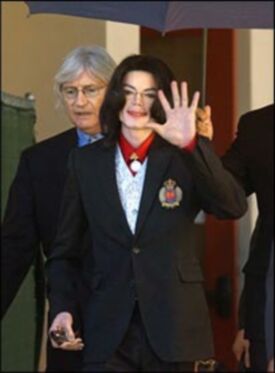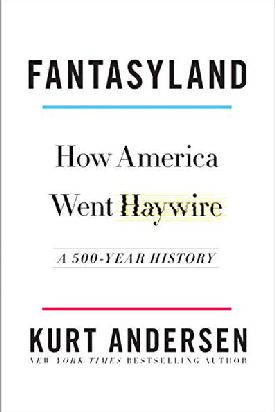‘Style’ Section Politics
From The New CriterionMichael Jackson, says Robin Givhan, the fashion correspondent of the Washington Post “appears incapable of wearing anything that does not resemble a costume, no matter how serious the circumstances.” It seems that the King of Pop showed up for his trial on the charges of child molestation dressed like, well, the King of Pop. On the trial’s second day, for instance, he wore
a dove gray brocade vest over a red shirt. Instead of a necktie — which he had skipped the day before as well — he wore a medallion at his neck. It wasn’t a bolo, which is typically a thin cord held in place by a sliding metal loop. Jackson’s neckwear was vaguely militaristic and subtlety aristocratic. His blazer had an elaborate crest off to one side. Trying to parse all the references and symbols in this ensemble — prep schooler, deposed royalty, honored citizen, embattled soldier — would keep a doctoral candidate in semiotics occupied for months.
Ah, yes, semiotics: the branch of philosophical linguistics that first made noticing such things as the get-up of Michael Jackson into a subject of serious intellectual study. But Miss Givhan, as befits a fashion correspondent, is not really a semiotician, except in the sense that we are all semioticians nowadays. She is just keen that people should dress for the occasion, as she had shown the week before when she wrote a column sharply critical of Vice President Cheney for attending the commemoration service for the 60th anniversary of the liberation of Auschwitz in “the kind of attire one typically wears to operate a snow blower.” Instead of dark overcoat, fedora and dress shoes, the Vice President had worn an anorak with his name on it, a ski cap labeled “Staff 2001” and hiking boots.
Yet Miss Givhan was also enough of a semiotician to recognize that, where Vice President Cheney had simply made a fashion faux pas, Michael Jackson might well have had a subtle end in view in adopting his foppish attire:
For Jackson, wearing gold armbands and bejeweled vests might be a savvy decision. They underscore the widely held belief that Jackson exists in his own world. That he doesn’t quite grasp the rules of adulthood because he never made the transition from childhood. Each ostentatious flourish sets Jackson apart. His attire emphasizes that he is nothing like his so-called peers. And if he is so unlike them, the logic might go, do the same standards apply?. . . It’s a unique courtroom style for a one-of-a-kind defendant. And it may prove to be more beneficial to Jackson’s case than a simple navy suit and tie ever could be.
In other words, it was not really a question of costume versus no-costume as she had suggested in her leading paragraph. It was a question of which costume would best suit his forensic purposes. Most people think it to their advantage to go to a trial in which they are the defendant costumed as ordinary guys and gals in order to induce the ordinary guys and gals of the jury to identify themselves with them. But if you are not only a celebrity but in a way the celebrity, the very embodiment of what it means to be a celebrity in the 21st century, as Michael Jackson is, it may well be more to your advantage to go costumed as a show-biz freak. The jury must instinctively understand that, by doing so, you will have performed essentially the same kow-tow to its opinion as the neighborhood thug or burglar in his navy suit and tie — that is, by condescending to live up to its expectations of you.
It’s a reminder, if any reminder were needed, of how much of public life is performance. In fact, the reminder we’re more likely to need these days is that, sometimes at least, it is something more than performance. Sometimes there are realities involved. Such a reminder might have been useful for the new associate editor of the Post and op-ed columnist, Eugene Robinson, who wrote in the paper on the same day as Miss Givhan’s semiotic essay to criticize President Bush for playing the villain rather than the hero in the disaster movie called Global Warming. Mr Robinson himself only recently migrated to the op ed page from the “Style” section of The Post, where he had been assistant managing editor, when someone with less seniority was appointed to the paper’s managing editorship in succession to Steve Coll. As the other person, Philip Bennett, the former foreign editor, is white and Robinson is black, there were strong feelings felt and strong words expressed by some in the Post’s racially divided newsroom who thought, or professed to think, that the appointment had been racially motivated. The associate editorship and the op ed column were Robinson’s consolation prizes and a sop to the restive troops inclined to suspicion of the management’s motives.
Yet for the reader, the consequence seems to have been the further importation of “Style” section politics to the editorial pages. Few “issues” before the public today elicit more in the way of public performance — some would say posturing — than that of Global Warming, and Mr Robinson’s point was that, by failing to mention the subject in his State of the Union address, the President had, in effect, missed one of the steps in the elaborate dance that public occasions like the State of the Union address have become — except that his analogy was drawn from the cinema rather than the ballet. Referring to the formulaic quality of the typical disaster film, Robinson wrote that the President was playing the role of the “Benighted Authority Figure” who refuses to see the volcano outside his window when the handsome young scientist who is the male lead — E. Robinson, as it might be — comes to him with anguished face and says something like: “That baby’s going to blow.”
Mr Robinson has his B.F.A. replying in insouciant tones: “Problem? I don’t see any problem, and I’ll tell you one thing: There’s not gonna be any evacuation, not on my watch. Now everybody back to work.”
Yet there is a reason why disaster movies are formulaic, and it is that real life is so seldom like them. Just as the delusions of movie paranoiacs are as monotonously right as those of their real-life counterparts are monotonously wrong, so in the same way the guy who says “there’s nothing to worry about, go back to work” is in real life almost as sure to be right as his movie counterpart is to be wrong. There’s no mystery about it. Drama is made out of life’s exceptional events rather than its most ordinary ones, and an obvious corollary of this obvious principle is that life as represented in the movies is back-to-front, the extraordinary made ordinary and the ordinary made extraordinary. Substantively, there was not only nothing that the President could do about Global Warming, there was nothing he could do even to contribute to the virtually insignificant palliative measures of the Kyoto Treaty which, when it came up for a vote under the auspices of the Clinton administration, was voted down in the Senate 98-0. In the absence of any better definition of “politically impossible,” those kinds of numbers will do very nicely. Nor were they in the least surprising, since living up to the Kyoto treaty’s provisions would have involved a massive curtailment of economic activity on these shores and have devastated the American economy far more than that of any of the countries who adopted it, most of whom would have been among the gainers from America’s loss.
That’s the worst part of the “Style” section’s expectation of drama in politics: it’s so often bad drama. Mr Robinson’s Benighted Authority Figure, for example, is as the name suggests a stock figure. The script demands of him only that he be stupid and, probably, corrupt, and beyond that it has no interest in him or in why he thinks as he does. Evil tends to be its own explanation in the movies, since if the B.A.F. didn’t exist we’d have to invent him. Oh, right. We did invent him. But in real life it’s not enough to call him a B.A.F. We have to justify the “benighted” part, and that Robinson like so many other journalists in a similar position, fails to do because he thinks it unnecessary to do. The script has already been written, after all, it’s the politician’s job simply to read the lines. It’s fair enough for Robinson to criticize Bush about Global Warming, but to do so responsibly he should have made some reference to the political impossibility of his doing what he, Robinson, recommends.
Not likely, I agree. But while we’re wishing we might as well wish for an acknowledgment that there is more than one opinion about the desirability of making the kind of immense commitment of resources it would take to make even a little difference in what is sure to happen anyway. The Danish scientist Bjorn Lomborg points out that “implementing Kyoto will cost $150-$350 billion globally every year, merely to postpone the temperature rise by six years from 2100 to 2106. It is a very expensive way to achieve very little.” And he adds that, “for the cost of Kyoto in just the year 2010, we could solve the biggest problem facing mankind: we could permanently provide clean drinking water and sanitation for every person in the world.” Maybe in real life, in other words, there is some method to the madness of the poor old B.A.F. But like many of us, Robinson has simply grown used to thinking of politics and public life in general as if there were nothing more to it than performance, nothing more than the tawdry disaster movie of the “Style” section.
It’s true that in the blurring of the distinction between political reality and the movies, presidents themselves have long been complicit. Only instead of disaster movies, they want us to see uplifting made-for-TV Hallmark specials. That’s why President Reagan, recently arrived in Washington from Hollywood and environs, first put Lenny Skutnik, the hero of the Air Florida crash into the Potomac, into the audience for his State of the Union address in 1982 and why, 23 years later, President Bush was still engaging in similar gestures with Safia Taleb al-Suhail, the daughter of an Iraqi dissident murdered by Saddam Hussein and Janet and Bill Norwood, the parents of a Marine who had been killed in Iraq. But when Miss Suhail and Mrs Norwood embraced as both were standing to receive the tribute of the audience, it was a drama too far for some. Back in the “Style” section so recently vacated by Mr Robinson, for example, Tom Shales was still harping on the show-biz aspect of the speech as if it were a scandal nobody had ever noticed before. “If George W. Bush could sing and dance to ‘Yankee Doodle Dandy,’” he had led off his review of the speech in the Post the day before, “he probably would have last night, as part of a sentimental patriotic spectacle technically known as the State of the Union address.”
You might suppose that it would have occurred to Mr Shales to think that, if the thing were not a bit of show-biz it would hardly have made sense for the paper to ask him, its television critic, to have written a review of it in the first place. But then he is one of the “Style” section politicoes who have given up the task of pronouncing on the aesthetic artefacts thrown up by our politics in favor of what they take to be more substantive critiques, including inquiries into the genuineness of the emotions our political showmen put on display. Thus Shales naturally had to say something about the fact that the President appeared for a moment to feel emotion at what quickly became known as “the hug,” writing that, “The president, strikingly, stared up at the balcony with little visible emotion on his face but eyes that appeared to be growing misty. Was this a genuine expression of America appreciating its men and women in uniform, or a shameless political stunt using grief-stricken parents as pawns?” he asks rhetorically. “As we all know in the age of media moments, it matters less what it was than what it was perceived to be, and to a greater degree than perhaps any other time since he’s been in office, Bush appeared to have the perception presidency well in hand.”
Ouch! And yet, once again I ask, if “the perception presidency” is such a bad thing, why does the Post employ a TV critic to judge it? Perhaps it is because Mr Shales so resents the task he has been assigned that he is so savage about the presidential extravaganza, but his underlying assumption that something other than the perception presidency is not only desirable but possible seems questionable at best. In fact, it strikes me as being just like Eugene Robinson’s assumption that Global Warming and no Global Warming are valid political alternatives. That’s not serious criticism. In fact, it is as gestural as anything the President gets up to. Neither Mr Shales nor Mr Robinson may have anything realistic to suggest, but both have learned to employ their critical talents in the higher cause of making their own insight or concern, and above all their own infinite superiority to those they criticize, the subject of every column. It’s a critic’s disease, and as a critic myself I know how easy it is to contract it. But the cure is to be subjected to criticism oneself, and that is what “Style” section politics so rarely allows to happen.
The nearest you can find to self-criticism is the sort of oblique apology for Mr Shales’s sourness and cynicism that was run by “Style” the following day in a conciliatory piece by Neely Tucker called “The Moment that America Embraced.” Without ever explicitly mentioning either the Shales insinuations or the outright skepticism among some others of the President’s habitual detractors, notably Chris Matthews and Ron Reagan during MSNBC’s coverage of the speech, Mr Tucker confidently informed his readers that The Hug was both genuine and spontaneous. “The women’s embrace was so unplanned that when Norwood started to pull back, the chain from her son’s dog tags, which she had been holding, became entangled in al-Souhail’s accoutrements,” he wrote breathlessly. “The women had to disentangle themselves on live television, the awkwardness lending the moment an unrehearsed charm. It was, by any measure, magic.” Well, maybe not by any measure but certainly by the measure of “Style” section politics, which is increasingly the only measure that matters at the Post as at other papers.
And for every pro-administration moment of magic such as this, there are dozens devoted to ostentatiously sober analysis casting the President as the B.A.F. — or worse — in the lurid blockbuster called All the World’s Problems and How Much I Care About Them, written and directed by some snippy columnist. The top exponents of “Style” section politics, Maureen Dowd and Frank Rich, work for the New York Times rather than the Washington Post, but in the “Style” section itself the most prominent practitioner is Tina Brown, whose regular Thursday column has become a highlight of the paper for many Washingtonians who read it each week to see if its previous heights of narcissism will be topped, as they often are. That’s why it was so remarkable that, on the very day when Tom Shales was submitting the President to his customary flaying, Stylish readers were introduced to a new and seemingly chastened Tina. As usual she projected her own feelings onto the People Like Us for whom she always speaks so confidently, but now the feelings were different — changed, changed utterly (at least for this week) by the Iraqi elections:
Democrats have spent the past four years sneering at George Bush’s lack of nuance, but now they’re sick of nuance themselves. Nuanced positions on Iraq just make them feel small. Liberals don’t want to be left spreading the grumpy notion that liberty can’t travel, even if it turns out to be true. . .Even reporters on the ground in Iraq could hardly believe what they were living through as they watched the power of an idea transmute into the living, breathing form of black-clad women, Marsh Arabs and throngs of Kurdish mountaineers festively making their way to the polls. The father of a young reporter who has spent most of the last two years in Iraq shared with me his son’s e-mail from Baghdad. “We journalists are all sitting round and asking each other how we missed what’s clearly a far deeper drive for political and societal change than we realized. It is a measure of our isolation here — and also, I think, a measure of how the violence and humiliation of the occupation has masked people’s very genuine feelings.”
Only a fortnight before, she had been banging on in her usual fashion about President Bush’s various world-endangering neuroses, with the nature and etiology of which she was on familiar terms since reading the latest book club favorite on the Upper West Side, Justin Frank’s “insight-crammed” Bush on the Couch. Now she was writing that “Every Bush hater you meet in New York is engaged with an inner struggle of how much to let go of the past.” True, she went on to compare their situation to that of “wives midway through marriage therapy designed to reconcile and foster a new beginning with a feckless husband who has perpetually let them down. Hillary Clinton knows what that feels like better than anyone else” — which may be why New York’s junior Senator seems to be trimming her sails, lately, to the prevailing starboard winds. But even so much of self-criticism as this represents could mark an epoch in the evolution of “Style” section politics. So, at any rate, I would like to believe.
Discover more from James Bowman
Subscribe to get the latest posts to your email.







